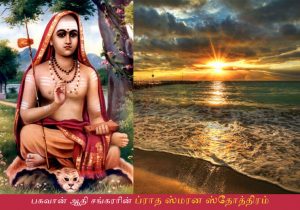Sadhana panchakam
Obeisance to Guru Sankaracharya.
In Sanskrit, the term ‘sādhana’ means an esteemed ‘endeavour’ and ‘pañchakam’ refers to that which is made up of five. So the title ‘sād¬hana pañ¬cakam’ refers to the five verses that provide the noblest endeavour for our spiritual uplift.
The ‘sādhana pañcakam’ has five verses; each verse has eight instructions; these forty instructions when followed diligently must lead to the heightened spiritual awareness. In his impeccable style and the masterly control over the language, Bhagavan Adi Sankara has given each instruction to the point, clear and succinct for us to comprehend and follow; each instruction is valid by itself and also a trigger for other instructions to progress.
Many declare that these verses are meant only for ‘sanyāsi’ who have renounced the worldly roles to wander, seeking only the salvation; perhaps these are. However, as told by great Seers, ‘sanyāsa’ is not just about wandering for salvation by absolving all earthly duties; it is also about leading a life without worldly desires yet remain committed for discharging our rightful duties dispassionately and being in complete harmony on the Earth. So the inspiring instructions such as ‘sād¬hana pañ¬cakam’ must belong to the whole humanity. The depth of understanding and the level of application of such instructions may differ between the ordinary mortals and the learned aspirants but the right to follow these divine instructions for the spiritual progress must belong to all.
For those who have the strength of surrender and unshakeable conviction on the scriptures of Sanātana-dharma, abiding by the instructions may be natural; to follow diligently may be difficult for some but the will to pursue would not be in question for them.
For other sincere seekers, there may be an intellectual need to understand the validity of these instructions; to them, there exist scores of literature giving deeper insights; but the best route is firstly to undertake a personal contemplation on each of these instructions and when there is an irresistible curiosity and undying yearning for the learning, then that would be the time to seek the guidance from the Learned who would readily impart the necessary steps to progress.
Here is an inspired interpretation of sād¬hana pañ¬cakam’ to aid our learning.
I seek the permission of Guru Adi Sankara for my indulgence to bring an inspired translation with the view to broaden the interest for spiritual sādhanā which must not be for a special group of people or scholars only. Such an approach would require some liberty in the translation, on the premise that the core of the subject is always intact.
As an example, the very first instruction is ‘vedo nitya¬mad¬hīy¬atām’. This literally means ‘One should study the Veda, the scripture, everyday’.
In Sanātana-dharma, Vedas are the ultimate declaration. Instantiated in the form of sound and imparted by the word-of-mouth, Vedas are said to be divine revelations from God, although Bhagavan Vyasa is said to be the systematic compiler.
In the olden days of Bharath, social order prevailed that defined clear arrangements of responsibilities or collective progress across the society; for example, it set aside one community to perform the role of ‘spiritual servants’ to the entire society, their onus being the study, compliance and propagation of Vedic wisdom to all; while carrying out similar and distinct social objectives, other groups would revere these ‘spiritual servants’ and although not able to directly learn the Vedas, they would readily take the guidance from the ‘spiritual servants’ to imbibe the values of Veda in their way of living .
Such perfect order of society is no more; treasures of Veda are not easily available for everyone to study; therefore a possible interpretation for this instruction could be ‘One should constantly learn the values and the applications of wisdom imparted from the scriptures for One’s conduct in the world. This would mean, even if one could not study and understand the Vedas in all their glory, their essential imports must be learned and revered as part of one’s daily life.
On that basis, an inspired interpretation in Tamil for the first instruction is:
‘maRai muRaigaL dhinamum payilka’.
In Tamil, the term ‘maRai’ is used for Vedas. By the term ‘maRai’ which means ‘hidden’, Tamil has beautifully captured the whole aspects of Veda, which is endowed with hidden treasures of spiritual wisdom.
The term ‘muRai’ refers to ‘the method’ or ‘the application’; so the term ‘maRai muRai’ indicates the rightful application of the hidden wisdom and the values in the Vedas.
The term ‘dhinamum payilka’ means to learn every day. Instead of the literal translation ‘maRai dhinamum payilka’, are we allowed to interpret it as ‘maRai muRai dhinamum payilka’?
In my humble view, the answer is yes.
The recital of Veda and the esoteric knowledge therein are not readily accessible or understandable by ordinary beings. So won’t there be an impasse even at the very first instruction if we interpret it as ‘maRai dhinamum payilka’?
Let me dare to say that the core essence of Vedas, as indicated by the ‘Upanishads’, the final part of Veda or Vedānta can be summarized in few beautiful words of Tamil:
‘maRaiyaay narrporuL IRai Yaan KadavuL’.
மறையாய் நற்பொருள் இறையான் கடவுள்
‘maRaiyaay naRporuL’ means, the good meaning based on the deeper contemplation of Vedas. The true wisdom of Veda is hidden in the words and sounds and would require deeper contemplation and guidance for the realization.
The hidden wisdom of Vedas as revealed by the great Seers is this: ‘iRai Yaan Kadavul’.
‘iRai’ means that which is spread everywhere, ever expanding. The term ‘IRaivan’ means God who is Omnipresent. Everything, every form and the expanse are nothing but God. The macrocosm is God.
In the term, ‘KadavuL’ the prefix ‘kada’ means ‘ by surpassing’ and ‘uL’ means the innermost. So the term ‘KadvuaL’ refers to That which by surpassing all within us, exist as the most impenetrable microcosm;
The term ‘Yaan’ means ‘Self’, which is generally identified by ‘I’. So, Yaan, the ‘I’, exist between the ‘iRai’, the macrocosm, and the ‘KadavuL’, the microcosm. By such contemplation, the true meaning of ‘I’ is to be understood, as the One that cannot be different from ‘iRai’ or ‘KadavuL’.
All three perspectives ‘Yaan’, ‘iRai’ and ‘KadavuL’ are the same; the same is said in ‘saiva siddandha’ as ‘pasu’, ‘pathi’ and ‘pasam’; in Vedanta as ‘jeevatma’, ‘paramatma’, ‘prakriti’ ‘pramatma’; when this is realized, there is no duality. Such realization requires firstly and finally, the true understanding of the ‘I’. When such understanding is complete, there is only One true existence which is All and Nothing; That is God and I am That.
Therefore the first instruction which is for the ‘daily study of Veda’ should mean sincere endeavour to instil the essence of Vedas as part of life every day, nay, every moment.
Another example is the last line of the first verse.
The instruction “nijagṛhāttūrṇaṁ vinirgamy¬atām” is typically taken to mean that One, upon achieving the Self-realization must ‘at once, depart from the house of dwelling’ – (nija = at once, gṛhāttūrṇaṁ = innate house, vinirgamy¬atām= to depart from). This is how many see the meaning to support the assertion that sād¬hana pañ¬cakam is only meant for ‘sanyasi’ who has renounced the house-holder life.
In order for these instructions to be applicable to all, I took the liberty to interpret the ‘innate house’ of the Self as the temporary abode made up of the physical, subtle and casual body-complex. By asking ‘to leave quickly’, it is indicated that as soon as Self-realization is achieved, for the realized Self, there would be no bindings of the embodiments and therefore at the very moment, the Self is free; in other words, the one is said to be out of the house. Free from embodiment could not be taken as ‘disembodiment’ or ‘death’ because the sād¬hana is for us to attain the state of ‘jivan mukta’ on the earth; therefore, ‘leaving the house’ can be taken to mean ‘leaving the attachment to the embodiment’. Such an interpretation would also allow the house-holders to benefit from the sād¬hana, as long as they instil detachment and desire less actions in their chosen paths on the earth.
Thus follows my interpretation for our perusal.
Mee. Rajagopalan
நற்பயிற்சி ஐந்துறை
குரு சங்கராசார்யாரின் திருவடிகளுக்குப் பணிவான வணக்கங்கள்.
சமஸ்கிருத மொழியிலே ‘ஸாதனா’ எனும் சொல்லுக்கு மேனிலைக்கான பயிற்சி அல்லது ‘நற்பயிற்சி’ எனவும், ‘பஞ்சகம்’ எனும் சொல்லுக்கு ‘ஐந்து பகுதி’ எனவும் பொருள். அதனால் ‘ஸாதன பஞ்சகம்’ எனும் பகவான் ஆதி சங்கரர் படைத்த பாடல்களுக்கு ‘நற்பயிற்சி ஐந்துறை’ எனக் கொள்ளுவோம். அதாவது மனிதவாழ்க்கையின் மேலான நிலைக்குச் செய்ய வேண்டிய பயிற்சிகளை ஐந்து பாடல்களில் சுட்டிக்காட்டிய பெரும் நிதி இது.
இதில் ஐந்து பாடல்களும், ஒவ்வொரு பாட்டிலும் எட்டுப் பயிற்சிக் கட்டளைகளுமாக மொத்தம் நாற்பது கட்டளைகளை ஆசான் அளித்திருக்கிறார். தமக்கே உரித்தான கவி நேர்த்தியிலும், மொழித் திறமையிலும், பகவான் அளித்திருக்கும் இச்சிறு பாடல் தொகுப்பு, நற்பயிற்சிக் கட்டளைகளைத் தௌ;ளத் தெளிவாகவும், நேரடியாகவும், நாம் பின்பற்றுவதற்கு ஏற்ற வகையிலே தருகின்றது. ஒவ்வொரு கட்டளையும் தனித்தே உண்மையாகவும், தொடர்ந்து வரும் மற்ற கட்டளைகளுக்கும் ஓர் தொடராதாரமாகவும் இருந்து, நமது ஆன்மீக முதிர்ச்சிக்கு வழிகாட்டுகின்றது.
பலரும் உலக வாழ்க்கையினைத் துறந்து, முக்தி விரும்பி, தவமாய் அலைந்து திரிகின்ற ‘ஸந்யாசி’ எனும் துறவியருக்கே இப்பாடல்கள் ஆக்கப்பட்டன என்பர். ஆயினும் பெரியோர்கள் கூறியபடி, துறவு என்பது காவி அணிந்து, உலகோடு ஒட்டாமல் இருப்பது என்பதல்லாமல், சுயநலமும் ஆசைகளும் இல்லாமல் தனக்கான கடமைகளை இறைப்பணியாய் ஆற்றி, உலகினோடு ஒப்ப, ஒட்டுதல் அறிந்தும் ஒட்டாது ஒழுகும் ஒழுக்கம் என்பதும் ஆகும். அதனால் ‘ஸாதன பஞ்சகம்’ எனும் இவ்வரிய பாடல்கள், மனித சமுதாயம் எல்லோருக்கும் பொது என்பது உண்மை. இப்பாடல்களின் ஆழ்பொருளை உணரும் பக்குவமும், அதன்படி நடக்கின்ற உறுதியும் வேண்டுமானால் ஒருவருக்கொருவார் மாறுபட்டிருக்கலாம். என்றாலும், இப்பாடல்களைப் படிப்பதும் அதன்படி பயிற்சி செய்ய முயற்சி செய்வதும் மனித இனம் எல்லோருக்கும் உரிமை. ‘ஸநாதன தருமம்’ எனப்படும் இந்து சமய மறை நெறிகளைப் பயில்பவருக்கும், மதிப்பவர்களுக்கும், இந்நூலின் கட்டளைகளை நம்பிக்கை ஒன்றின் காரணமாகவே ஏற்றுக் கொள்வது என்பது இயற்கையாய் இருக்கும். தொடந்து அதன்படி முறை தவறாமல் நடப்பது வேண்டுமானால் முதலில் கடினமாய் இருக்கும். ஆனால் அவர்களுக்கு, இப்பயிற்சியின் அவசியம் பற்றியோ, செய்ய வேண்டிய உறுதி பற்றியோ எவ்வித இடரும் இல்லை.
மற்றவர்களில், உண்மையான ஆன்ம முன்னேற்றம் விருப்பமுள்ளவர்களுக்கு, முதலில் இக்கட்டளைகளுக்கான காரணத்தை ஆய்ந்தறிதல் வேண்டியிருக்கும். அதற்கான உதவியாக எத்தனையோ நூல்கள் பெரியோர்கள் தந்திருக்கிறார்கள். எனைப் பொறுத்தவரை, மிகச் சிறந்த வழி என்பது, முதலில் இக்கட்டளைகளைத் தானே படித்து, அவற்றை மனதாலும் அறிவாலும் ‘ஏன், எதற்கு’ என்ற கேள்விகளால் ஆராய்ந்து, எப்போது மனத்தில் கேள்விகளின் பளுவும், அக்கேள்விகளுக்கான விடைகளை அறியும் பேர் உந்துதலும் அதிகமாகி, ஆர்வத்தால் துடிக்கச் செய்கின்றதோ, அப்போது தனக்கு வழிகாட்டக் கூடிய ஆசானைத் தேடினால், அவர் நிச்சயமாகக் கிடைத்து, அவர் மூலமாக மேலும் ஆன்மநல முன்னேற்றத்துக்கான வழி நமக்கு ஏற்படும் என்று தோன்றுகிறது.
அந்த ஆர்வத்தால், ‘சிறுமதியான் யான்’ எனும் சிந்தனையை விட்டுவிட்டு, ஆசானின் ‘ஸாதன பஞ்சகம்’ எனும் அமுதப்பாடல்களை ‘நற்பயிற்சி ஐந்துறை’ எனத் தமிழால், எல்லோருக்கும் பயனளிக்குமே என்ற பேரவாவினால் அளிக்கத் துணிந்தேன். பிழைவராது எனைத் திருத்தி நடத்தி, திருவருள் அனுமதியும் ஆசியும் தருமாறு பகவான் ஆதிசங்கரரின் திருவடித் தாமரைகளில் வணங்கி அடங்கினேன்.
மொழிபெயர்க்கும்போது, கருப்பொருள் மாறாமல் பார்த்துக்கொள்ளும் கடமையினூடே, பரந்து அறிவதற்காக சுதந்திரமான வார்த்தைச் செருகலும் தேவை என்பதைக் குறிப்பிடுகின்றேன்.
உதாரணமாக, முதல் கட்டளை ‘வேதோ நித்யம் அதீயதாம்’ எனும் வடமொழி வாக்கியப்படி, ‘தினம் மறை பயில்க’ என்பதாகும்.
நமது ஸநாதன தர்மத்தில், வேதங்கள்தான் முதலும் இறுதியுமான உண்மை. ஒலிவடிவாக விளங்கி, வாய் வழியாகச் சொல்லித்தரப்பட்டு வருகின்ற வேதமந்திரங்கள் இறைவனால் தரப்பட்ட அநாதியான மந்திரங்கள் என்பது மேலோர் கருத்து. வேத வியாசர் எனும் பெரு முனிவர் வேதங்களைத் தொகுத்து அளித்தவர் என்றாலும், வேதங்கள் இயற்கை விளைத்த அறிவு.
முந்தைய கால பாரத நாட்டில், சமுதாயத்தில் தருமத்தால் விளைத்த கட்டுப்பாடு இருந்தது. எடுத்துக்காட்டாக, சமுதாயத்தில் ஒருபகுதியினர், ‘ஆன்மிகச் சேவர்களாக’ இருந்து, வேதங்களைப் படிப்பதும், படிப்பிப்பதும் மற்ற சமுதாயத்திற்கு ஆன்மிக வழிகாட்டும் அறப்பணி செய்வதுமாக, பொதுச் சேவை செய்து, எளிய வாழ்க்கை வாழ வேண்டும் என்று விதிக்கப்பட்டு, அதன்படி இருந்து வந்தனர். மற்றவர்களும் ஆளுமை, வாணிபம், சமுதாயப் பணி எனத் தனித்தனியான கட்டுப்பாட்டுகளை ஏற்றும், ஆன்மிகச் சேவர்களாக இருப்பவர்களை மதித்தும், அவர்கள் மூலமாக வேத வழி வாழ்க்கையை வாழ்ந்தும் வந்தனர். எவ்வாறு உடலில் ஒவ்வொரு உறுப்பும் அதனதன் பணியைனைச் செய்து சீராக வளருகின்றதோ அதே போல சமுதாயமும் வளர்ந்து வந்தது.
அத்தகைய அருமைச் சமுதாய நெறி இன்று இல்லை. வேதங்களை அறிவதோ, அவற்றைப் பாதுகாத்து ஒழுகுவதோ அரிதாகிவிட்டது. எனவே ‘வேதங்களை தினமும் பயிலவேண்டும்’ எனும் கட்டளையினை, ‘வேதங்களின் அறத்தை வாழ்க்கைக்குப் பயன்படுத்தும் பாடங்களாக தினமும் பயில வேண்டும்’ என்று எடுத்துக் கொள்வது அவசியம். அப்படிக் கொள்வதனால், மனித சமுதாயத்தில் எல்லோருமே, ‘வேதம் உணர்த்தும் நெறிதனைத் தினமும் பயில்தல்’ அவசியம் எனும் கட்டளையாக மாறி, அதனை நிறைவேறும் சாத்தியக் கூறுகளையும் அதிகமாக்குகின்றன.
அந்த வகையிலே, முதல் கட்டளை ‘மறைமுறை தினமும் பயில்க’ எனத் தமிழ்படுத்தப்பட்டது.
தமிழில், ‘மறை’ எனும் அருமையான சொல் வேதங்களைக் குறிக்கிறது. ‘மறை’ என்பதன் பொருள் ‘மறைத்திருப்பது’ என்பது ஆகும். அச்சொல்லின் மூலம் தன்னுள் பல பேருண்மைகளைப் புதைத்து வைத்திருக்கும் வேதங்கள் தமிழில் தக்க பெயரைப் பெற்றுவிட்டன.
தமிழில் ‘முறை’ என்ற சொல்லுக்கு ‘செயல்படுத்தும் வழி’ என்று பொருள். எனவே ‘மறை முறை’ என்பது வேதங்களின் வழி வாழும் வாழ்க்கை நெறி என்று ஆகிறது. அதனைத் ‘தினமும் பயில்க’ என்பதன் மூலம், முதற் கட்டளையின் பொருள், நாம் தினந்தோறும், வேத தர்மங்கள் என்ன என்பதையும் அதன்படி வாழ்வை அமைத்துக் கொள்ளும் வழிவகைகளையும் பயிலவேண்டும் என்று ஆகிறது.
‘மறை தினமும் பயில்க’ என்பதை மாற்றி ‘மறை முறை தினமும் பயில்க’ என்று மொழி பெயர்த்தது சரியான செயலா? என்னுடைய பணிவான பதில், அது சரி என்பதே!
வேதங்களை சரியாக உச்சரித்து அறிவதும், அதில் அடங்கியுள்ள அரிதான மறைபொருளைச் சரியாக உணர்வதும், எல்லோருக்கும் எளிதான செயல் அல்ல. அப்படி என்றால், முதல் கட்டளை ஒன்றையே மனித சமுதாயம் பின்பற்ற முடியாமல் போய்விடும் அல்லவா?
வேதங்களின் ஆழ்ந்த பேருண்மைகளின் திரட்டு, வேதங்களின் முடிவாக விளங்கும் வேதாந்த உபநிடதங்களில் விளக்கப்பட்ட பர அறிவு எதுவென, அமுதத்தமிழில் சுருங்கக் குறித்துக் காட்டும் சொற்களால் காட்டுபட வேண்டுமானால், அதனை கீழ்க்கண்டவாறு சொல்லலாம் என்பது எனது துணிவு.
'மறையாய் நற்பொருள் இறையான் கடவுள்'
‘மறை ஆய்ந்த நற்பொருள்’ என்பது வேதங்களை ஆய்ந்து உணர்ந்த நல்ல பொருள் என்பது ஆகும். இந்த நற்பொருள், வேத மந்திரங்களில் உபநிடத உண்மைகளில் வித்தாய், வேராய் இருக்கிறது. அந்த நற்பொருள் ‘இறை யான் கடவுள்’ என்பது.
தமிழில் ‘இறை’ என்ற சொல்லுக்கு, எங்கும் இறைந்த பொருள் என்றும், விரிந்த, பரந்த உலகத்தினையும், அவ்வாறு எல்லையிலாப் பொருளான இறைவனையும் குறிக்கும். கடவுள் எனும் சொல், ‘கட’ எனும் சொல்லால் ‘கடந்து, அப்புறமான’ என்ற பொருளையும் ‘உள்’ எனும் சொல்லால் ‘உள்ளம்’ என்பதையும் அதனால், ‘கடவுள்’ என்பது, உள்ளத்தினைக் கடந்த உணர்வு என்று ஆகும். உள்ளம் என்பது எண்ணம் விளைப்பது. எண்ணமே காலம்,தேசம் எனும் பரிமாணங்களைப் படைத்து அதன்மூலம் தான் காணும் உலகங்களைப் படைக்கிறது. எனவே உள்ளம் கடந்த உணர்வு என்பது, காலம், தேசம் எனும் பரிமாணங்கள் கடந்த சக்தி என்று காட்டுகின்றது.
‘யான்’ எனும் சொல், தான் என என்னைக் குறிக்கிறது. பரவிக்கிடக்கும் பிரமாண்டமான பல பொருட்களாக இறைவன் என்று ஒருபுறம், காலா தேசம் கடந்த நுண்ணுர்வாய் கடவுள் என்று மறுபுறம், இடையில் ‘யான்’ எனும் அகந்தையால் நான். ஆய்ந்து நோக்கில், இம்மூன்றும் ஒன்றே.
பசு, பாசம் , பதி எனச் சைவ சித்தாந்தமும் யான், இறைபொருள், கடவுள் எனும் இம்மூன்றைத்தான் காட்டுகின்றன. வேதாந்தம் காட்டும், ஜீவாத்மா, பிரகிருதி, பரமாத்மா எனும் நெறிகளும் இதனையே காட்டுகின்றன. ‘ஈரல்ல ஒன்றே’ எனும் அத்வைத தத்துவம், யான் எனும் மயக்கம் அழியும் போது, ஒன்றான பரப்பிரம்மத்துடன் யாவும் கலந்து நிறைவதே முக்தி என்று காட்டுகிறது. அந்நிலையில் எல்லாமுமாய், எது அல்லவுமாய் இருப்பது கடவுள்;. அதுவே யான்!
எனவே ‘மறை தினமும் பயில்க’ எனும் கட்டளை, எல்லா மனிதருக்கும் பயன்பட வேண்டுமென்றால், ‘மறைமுறை தினமும் பயில்க’ என்று மொழியமைப்பில் கொள்வது சரி என்பதே எனது பணிவு.
மற்றுமொரு எடுத்துக்காட்டு முதல் பாடலின் கடைசி வரியின் மொழிபெயர்ப்பு.
‘நிஜ க்ருஹாத்தூர்நம் விநிர்கம்யதாம்’ எனும் கட்டளையின் பொருள், ‘உடனடியாக வீட்டைவிட்டு வெளியேறு’ என்பதாகும். அதாவது ‘ஆன்ம அறிவானுபவம்’ கிடைத்த உடனே, தானிருக்கும் வீட்டினை விட்டு வெளியேற வேண்டும் என்று பொருளாகிறது. பலரும் அப்படியே பொருள் கூறி, அதனாலேயே ‘ஸாதன பஞ்சகம்’ எனும் இப்பாடல்கள், துறவறம் ஏற்கும் சந்நியாசிகளுக்கு மட்டுமே உரியது என்று காட்டி இருக்கிறார்கள். ஆனால், இவ்வரிய நூல், மனிதர் எல்லோருக்கும் பயன்பட அருளப்பட்டது என்ற உறுதியின் காரணமாக, பாடலின் இவ்வரிகளுக்குப் பொருத்தமாய் இருக்கக்கூடிய மற்றொரு கருத்தினை மொழிபெயர்ப்பில் காட்டி இருக்கிறது.
இங்கே வீடு என்பது நாம் உலகில் வசிக்கும் வீட்டினைக் குறிக்கவில்லை. ஒருவருக்கு ஆன்ம அறிவானுபவம் கிடைத்தால், வீடு என்பது ஆன்மா வசிக்கின்ற இடமென்றும், அவ்விடம் தோல், சதை, எலும்புகளான வெளிஉடல் (வல்லிய உடல்), மூச்சு, மனம், அறிவு ஆகியவற்றால் ஆன உள்ளுடல் (துல்லிய உடல்), வினைப்பயனாலாகிய காரண உடல் என மூன்றின் கட்டாயத்தால் கட்டப்பட்டதாய் இருக்கிறது என்றும், அவ்வீடு ஆன்மா எனும் யான் அல்ல, அவ்வீட்டின்மேல் ஆன்மாவிற்குப் பற்று ஏதும் இல்லை என்பதும் புரியும். அப்படி உணர்ந்த உடனேயே, ஆன்மாவிற்கு இவ்வீடாகிய பந்தம் இல்லை.
உடலாகிய வீட்டின் உறவு ஒருவருக்கு இல்லை என்பதன் பொருள், உடலற்ற நிலை என்றோ மரணம் என்றோ கொள்ளத்தக்கது அல்ல. ஏனெனில், ஸாதன பஞ்சகம் மனிதனை உலகில் வாழும்போதே ‘ஜீவன் முக்தன்’ எனும் இறையறிநிலை அடையச் செய்யப் படைக்கப்பட்டது. அதனால், உடலாகிய வீட்டைத் துறப்பது மரணம் அல்ல, உடலின்பால் கொண்டுள்ள பற்றைத் துறப்பது என்றே ஆகும். இப்படிப் பொருள் கொள்வதால், ஸாதன பஞ்சகம், துறவிகள் என்றில்லாமல், குடும்பவாழ்வில் ஈடுபட்டிருப்பவருக்கும், மனதால் துறவு, பலன் கருதாக் கடமை ஆகிய நற்பண்புகள் இருப்பின், அவர்களுக்கும் வழிகாட்டியாக இருக்கும் என்றே தோன்றுகிறது.
அந்த வகையிலே, இவ்வைந்து பாடல்களில் பதிந்த நாற்பது கட்டளைகளின் தமிழ் (மற்றும் ஆங்கில) வார்ப்பினைப் படித்துப் பயன்பெறப் பணிவினால் படைக்கிறேன்.
அன்புடன்
மீ. ராஜகோபாலன்
16 அக்டோபர் 2013






